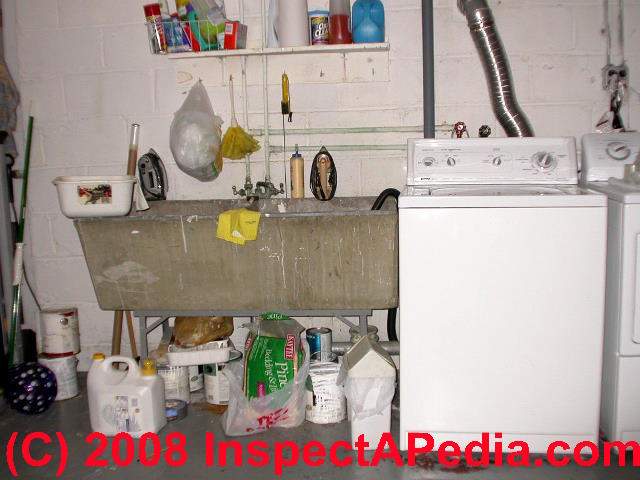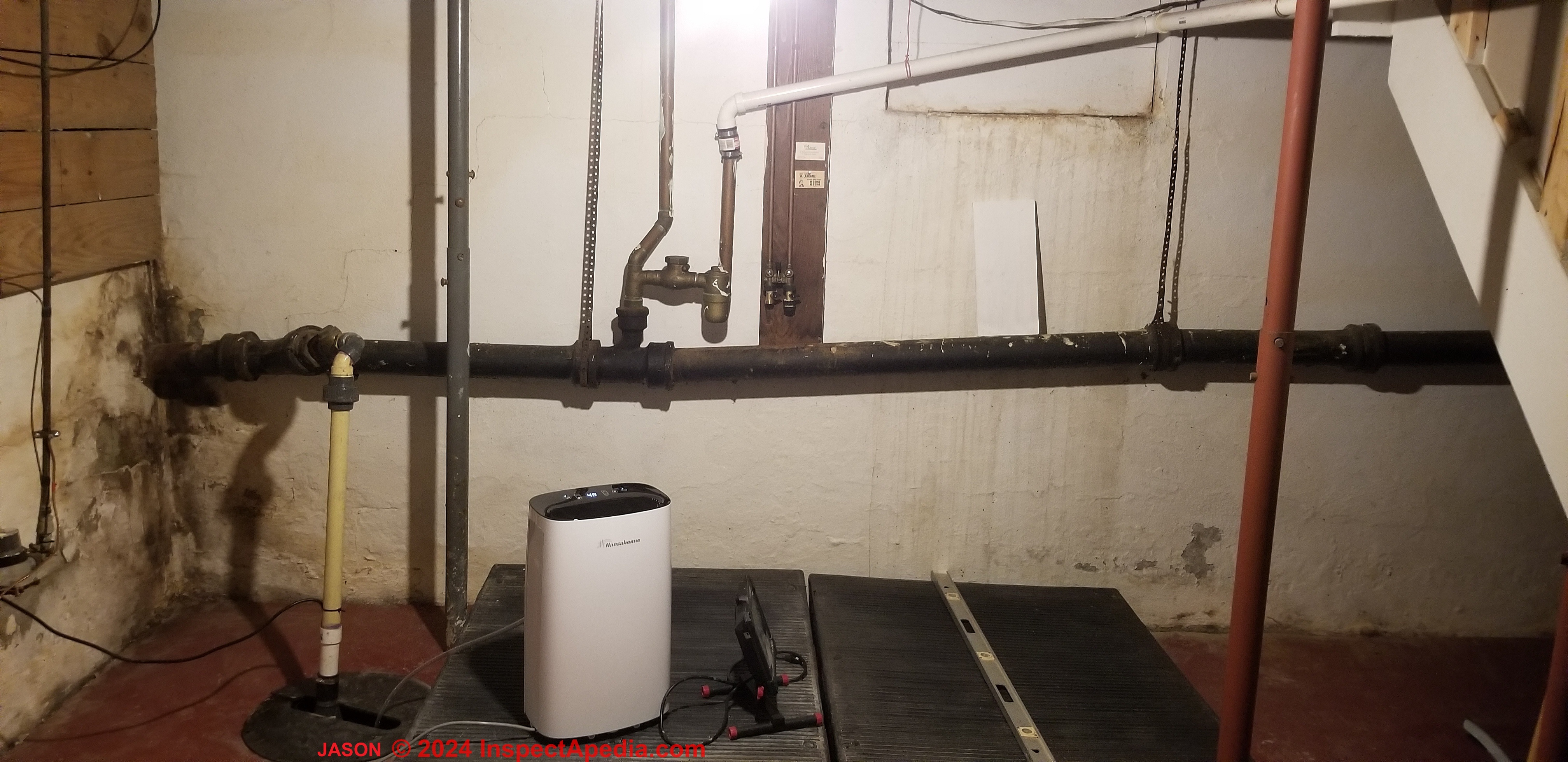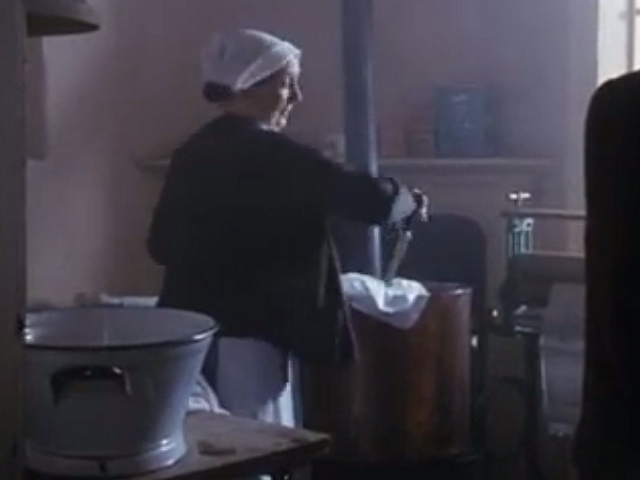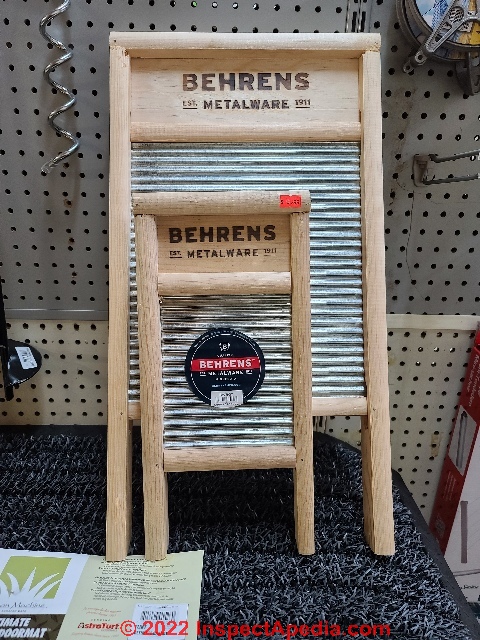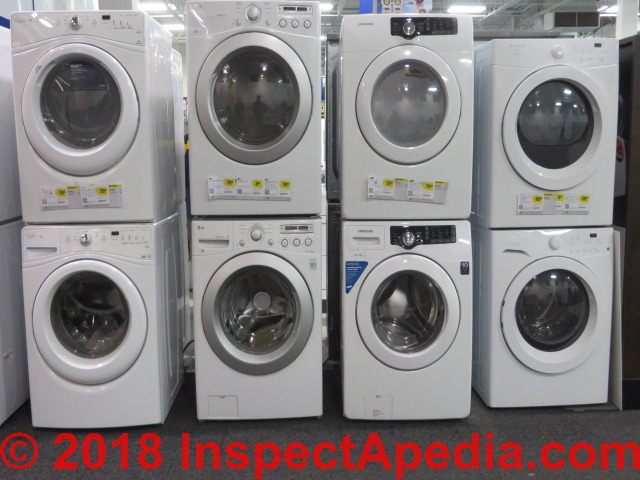 Washing Machine Troubleshooting & Repairs
Washing Machine Troubleshooting & Repairs
Home: installation, wiring, plumbing hook-up & repair tips
- POST a QUESTION or COMMENT about : diagnosis & repair help for home appliances
Washing Machine installation, troubleshooting & repair basic instructions & suggestions.
This article describes simple steps that you can take to get a clothes washing machine working again, or to decide that it's time to buy a new one, or that you would be smart to call an appliance repair person.
InspectAPedia tolerates no conflicts of interest. We have no relationship with advertisers, products, or services discussed at this website.
- Daniel Friedman, Publisher/Editor/Author - See WHO ARE WE?
Washing Machine Inspection & Repair
Article Contents
- WASHING MACHINE PLUMBING HOOK-UP
- WASHING MACHINE & DRYER ELECTRICAL HOOKUP
- WASHER / DRYER HOOKUP: FIX OTHER BASEMENT ISSUES?
- WASHING MACHINE TROUBLESHOOTING & REPAIR TIPS
...
Washing machine plumbing connections
- Washing machine hookup hoses:
Braided steel hoses are preferable to rubber hoses for connecting washing machines to supply piping in the home because the exterior steel braid reduces the chance of a burst washing machine water supply hose.
A ruptured hose can result in serious water damage in a short time, especially if the laundry area is in or above a finished area of the home. - Automatic water shutoff for washing machine:
For even more protection, there are automatic shut-off valves available that turn off the water in the event of a burst hose. - Washing machine drain pan:
When a leaking washing machine (or hoses) may cause damage to finishes, a washing machine drain pan may be installed to collect water in the event of a failure. Fittings on these pans should be connected to a drain so that the water can be safely discharged. - Washing machine drain hose hookup:
The waste hose can discharge into a laundry sink or into a waste standpipe connected to the waste plumbing through a trap.
The waste standpipe (standing waste pipe) should extend 18 to 30 inches above the trap. The drain hose should fit loosely into the standpipe so that there is an air space to prevent back-siphoning.
...
Washing Machine & Clothes Dryer Electrical Wiring Hookup
Reader Question: Where should I route wiring for my washing machine and dryer?
Attached is an image of the area where I am going to be installing a washer and dryer.
I was wondering what the electrical supply spacing should be around the water supply and the sewer line which runs across the wall.
Should the wiring be above or below the sewer line?
I am adding a 220 receptacle for the dryer and a 120 receptacle for the washer on the wall.
Thank You, Jason jgtoman@aim.com
Moderator reply: across basement ceiling, down wall, not under leaky basement window
You'll find that when adding electrical receptacles for a basement washer and dryer it is going to be much easier to get power to the spot for those appliances by running the circuit wiring in the basement ceiling, and then down the wall, rather than running it along the concrete block foundation wall.
About just how high above the floor to place the electrical receptacles for both washer and dryer, electrical codes don't specify a required height above the floor.
But there is an important access note: consider that the sewer line (yours has a sag at that tee that might turn out to be a clog spot) would block easy access to plug-in or unplug the appliances if you put the receptacles below the drain line.
So you should put the electrical receptacles above the drain pipe in your photo.
Watch out: I'd avoid putting wiring or electrical receptacles on wall sections where we know there has been a history of water running down the wall, such as below that boarded-up basement window.
You may be OK putting the two receptacles over to the left of that vertical drain, or washer at left and dryer further right, even to the right of the basement window - as long as both washer and dryer electrical cords can reach to the receptacle's location without an extension cord.
Forgive me but looking more closely at your photo I saw quite a few other concerns, at least some of which you should address.
See WASHING MACHINE HOOKUP: FIX OTHER BASEMENT ISSUES? (my annotated photo is below).
In that photo you'll see that in addition to my blizzard of worries about this basement, I marked possibly reasonable locations for a washing machine electrical receptacle at left (beige box with a white wire from above) and an electric clothes dryer receptacle at right (green box, with a white wire from above).
Alternatively, you might squeeze the electric dryer hook up receptacle to the left rather than the right side of that basement window.
ELECTRICAL WIRE CLEARANCE FROM DUCTS & PIPES - you'll see wires can run within an inch of pipes.
ELECTRICAL RECEPTACLE HEIGHT & CLEARANCES will also be of help to you in confirming where you place the receptacles for both washer and dryer.
More notes about successful clothes dryer installation and use are in our separate article found
at CLOTHES DRYER INSTALLATION & REPAIR
...
Basement Plumbing & Water Entry & Structural Concerns: before hooking up your washing machine/dryer
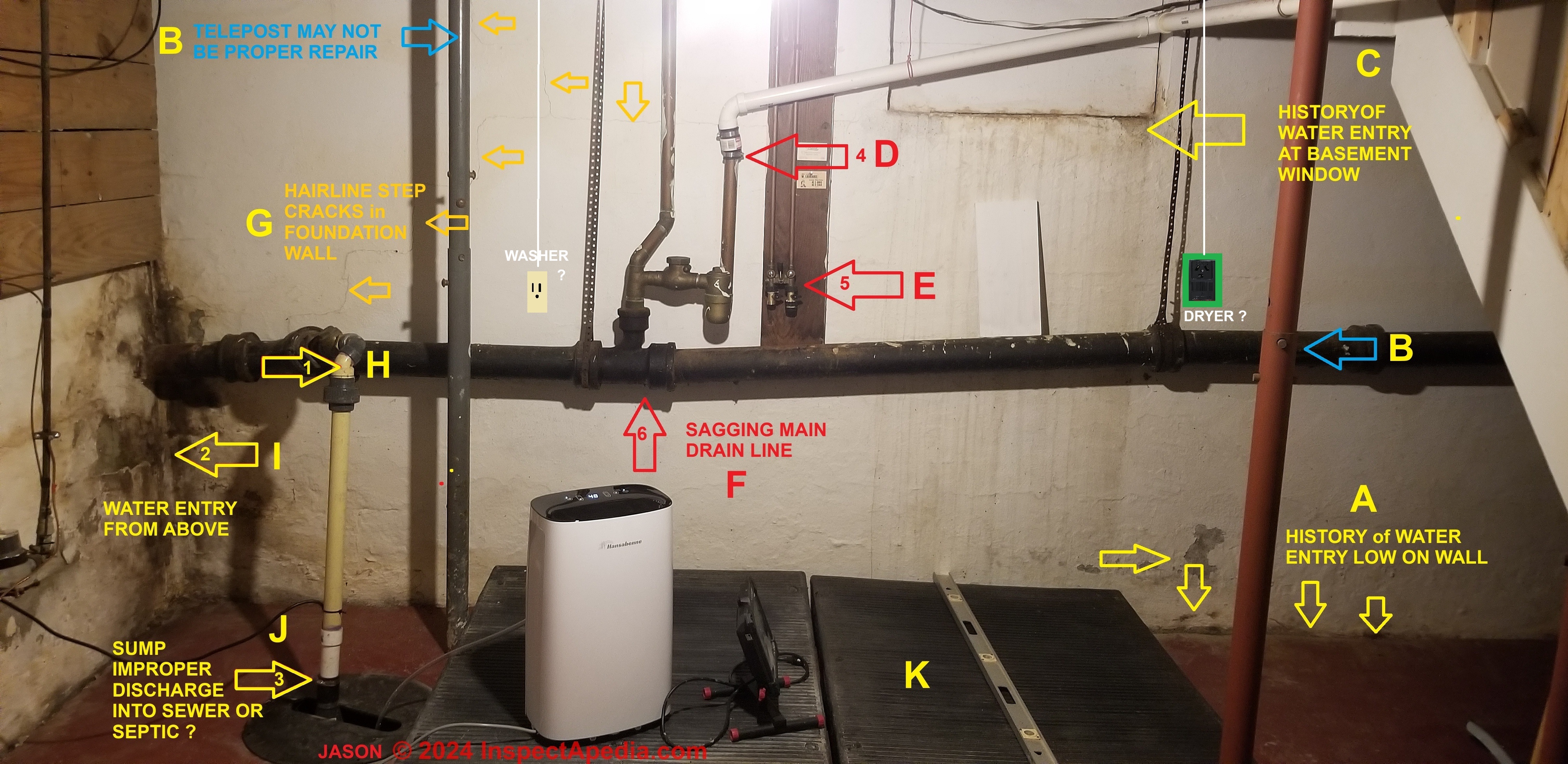
Watch out: looking more-closely at your photo I see quite a few other concerns, at least some of which ought to be considered before setting your clothes washer and dryer in place.
From right to left in the picture above, and with the apology that an onsite expert will always find more and can explain more than I can about a building from a single photo, here are some observations beyond what you asked but that I fell obligated to provide.
- A - Water entry stains: there is a history of basement water entry including low on the wall, with some spalling paint
Help is at - B - Questionable use of jackposts: there are two teleposts that have been added, supporting, presumably, the floor above. In some jurisdictions these are not permitted as a permanent repair and in this installation it looks as if they're upside down. In a wet basement there is risk of rust-through of the hollow column and then collapse.
For a dramatic example of how serious this can be, see
COLUMN / POST RUST DAMAGE - C - Water entry stains: there is also a history of basement water entry from ground level, showing up as water tracks under that now boarded-up basement window.
Be sure your roof gutters and downspouts are working properly and directing water well away from the building - D - Washing machine drain conflicts: there is an existing washing machine drain standpipe and trap that you'll probably use, but someone has made an improper air-tight connection to the top of that drain line, a use that may interfere with using that same drain line for the clothes washer unless the hookup is modified to be large enough for both drains AND to provide the necessary air inlet or "air gap" for the washing machine drain hose.
To understand why an air break or gap is essential to avoid contaminating a building water supply
see CROSS CONNECTIONS, PLUMBING
Above we show a proper clothes washer drain hookup, courtesy of Carson Dunlop Associates, a Toronto home inspection and education company.
About the size or diameter of the existing washing machine drain and its height above the floor,I couldn't tell the diameter of that standpipe - it needs to be larger in diameter than the washer drain hose so that air can get into the drain around the hose. An older one might be just 1.5" - if that works you don't need to go to the current standard 2" diameter drain.
Your washer drain top may be more than 30" above the floor level; most washing machines can pump a bit higher than that 36-inch maximum height of the washiing machine drain from the floor level, and if your washing machine is also going to be raised up a few inches from floor level by those plastic flood protection pads, that buys you some additional cleareance..
I'd try the washing machine connected to the existing drain before going to the expense of installing a laundry sink and ejector pump to lift the washing machine drainage up to the existing washer drain top.
Also see PLUMBING VENT CODES, DEFINITIONS, TYPES
- E - it looks as if there is an existing washing machine water supply hookup, so we infer that there was a washing machine previously in this basement.
- F - Drain Line Sag: the main building drain line has a pretty significant sag at that tee, making clogs likely and risking a sewage backup in the home. You may want this repaired before going ahead with the washer.
All building drain lines including that main sewer pipe need a minimum pitch of 1/8 to 1/4" per foot (continuous throughout the drain) to avoid clogging. - G - Foundation cracks: hairline step cracking and horizontal cracking in the concrete block foundation wall add evidence of a history of water outside this foundation wall. If the home is in a freezing climate, that can add to foundation damage.
I don't assert that this cracking requires a foundation repair but it adds to the importance of getting roof drainage and surface water away from the building outside.
To check my opinion (and of course we can't see the rest of the foundation)
See FOUNDATION DAMAGE SEVERITY assessment suggestions - H - and J - Improper sump pump hookup: your basement sump pump is connected directly to the building sewer line.
This connection is usually improper: if a home is on a private septic system the risk flooding the septic drainfield, leading to expensive septic system repairs and risking a sewage backup in the home.
When a home is connected to a public sewer, (as you say yours is) in most jurisdictions it is both improper and illegal to dump groundwater and a basement dewatering sump into the sewer line.
The concern is overloading the public sewer that in turn can cause sewage back-flooding into homes through such a connection when the sewer system became overloaded.
For example, from the Uniform Plumbing Code (UPC,) where the water removed by a basement sub-slab sump pump that is in essence a dewatering system, we have from UPC Chapter 11 Storm Drainage,
UPC 1101.3 Prohibited Drainage
Storm water shall not be drained into sewers intended for sewage only.
- I - Water entry stains: these water stains in the basement corner add to the history of water entry and again point to a water source coming from ground level.
My OPINION is that it's always better to get water away from the building outside than to let water come in and then try to get rid of it with a sump pump and dehumidifier and heat lamp.
- K - Basement flooding? those black plastic sections set on the floor suggest that someone was trying to keep a previous washer/dryer above the water level of a flooded basement floor. It'd be better for the whole building to address the water entry problem, starting outdoors.
See EXTERIOR WATER SOURCE ELIMINATION
...
Washing Machine installation & troubleshooting tips
Above: a housekeeper using a wooden stick to push clothes into an antique copper clothes washing machine featured in an Hercule Poirot mystery.
- If the washing machine does not work,
the power cord may be damaged or disconnected, the fuse or breaker at the main panel may have tripped, the motor may be inoperative, a control switch may be defective, or the water may be shut off or disconnected. - If the washing machine won’t fill,
one of the solenoid valves or control switches may be inoperative, or the water valves may be closed. [You checked to assure that the water valves are "on" at the washer hose hookup - right?] - If the washing machine won’t drain,
the pump or one of the control switches may be inoperative.
A drip pan and drain should be provided for machines above finished spaces.
Below: the second most-basic type of clothes washing machine, washboards.
The most basic clothes washing methods in many parts of the world involve taking clothes to a stream and using soap, water, and smashing the wet clothing on a flat rock.
- Water leakage at the washing machine
may come from the water supply hoses, pump, tub seals, or the drain hose.
There may also be a problem with the water level switch, or the tub itself may be damaged. On front loading machines, there may be a problem with the door or door seal. - Oil leaks or grease stains
at the washing machine or found on clothes after the wash may be traced to a failing transmission seal.
See WASHING MACHINE OIL LEAKS. - Unbalanced loads or a machine that is not level
often cause excessive vibration, even wobbling, or may cause the washing machine to "walk" across the floor.
There may also be problems with the motor bearings, the transmission or drive belt. - Front-loading washers can be prone to odor problems.
These musty odors are often the result of water that does not completely drain out of the washer.
The stagnant water may collect beneath the door gasket, in the fabric softener dispenser, or another location. In many cases, cleaning these areas will correct the problem, and leaving the door open will allow the water to evaporate without becoming stagnant.
Thank you to our readers for their generous comments
With all the information on YouTube - positive & negative; I wanted to get your feedback to help with my installation.
I had this web page saved for years and have refered to it numerous times for past projects, and recommend it others.
Thank you for all your feedback on my concerns, you have been most informative. - Private email to editor, 2024/11/21
...
Continue reading at APPLIANCE EFFICIENCY RATINGS or select a topic from the closely-related articles below, or see the complete ARTICLE INDEX.
Or see these
Recommended Articles
- APPLIANCE DIAGNOSIS & REPAIR - home
- CLOTHES DRYER INSTALLATION & REPAIR - home
- WASHING MACHINE REPAIR - home - you are on this page
Suggested citation for this web page
WASHING MACHINE REPAIR at InspectApedia.com - online encyclopedia of building & environmental inspection, testing, diagnosis, repair, & problem prevention advice.
Or see this
INDEX to RELATED ARTICLES: ARTICLE INDEX to APPLIANCE REPAIR
Or use the SEARCH BOX found below to Ask a Question or Search InspectApedia
Ask a Question or Search InspectApedia
Try the search box just below, or if you prefer, post a question or comment in the Comments box below and we will respond promptly.
Search the InspectApedia website
Note: appearance of your Comment below may be delayed: if your comment contains an image, photograph, web link, or text that looks to the software as if it might be a web link, your posting will appear after it has been approved by a moderator. Apologies for the delay.
Only one image can be added per comment but you can post as many comments, and therefore images, as you like.
You will not receive a notification when a response to your question has been posted.
Please bookmark this page to make it easy for you to check back for our response.
IF above you see "Comment Form is loading comments..." then COMMENT BOX - countable.ca / bawkbox.com IS NOT WORKING.
In any case you are welcome to send an email directly to us at InspectApedia.com at editor@inspectApedia.com
We'll reply to you directly. Please help us help you by noting, in your email, the URL of the InspectApedia page where you wanted to comment.
Citations & References
In addition to any citations in the article above, a full list is available on request.
- In addition to citations & references found in this article, see the research citations given at the end of the related articles found at our suggested
CONTINUE READING or RECOMMENDED ARTICLES.
- Carson, Dunlop & Associates Ltd., 120 Carlton Street Suite 407, Toronto ON M5A 4K2. Tel: (416) 964-9415 1-800-268-7070 Email: info@carsondunlop.com. Alan Carson is a past president of ASHI, the American Society of Home Inspectors.
Thanks to Alan Carson and Bob Dunlop, for permission for InspectAPedia to use text excerpts from The HOME REFERENCE BOOK - the Encyclopedia of Homes and to use illustrations from The ILLUSTRATED HOME .
Carson Dunlop Associates provides extensive home inspection education and report writing material. In gratitude we provide links to tsome Carson Dunlop Associates products and services.


